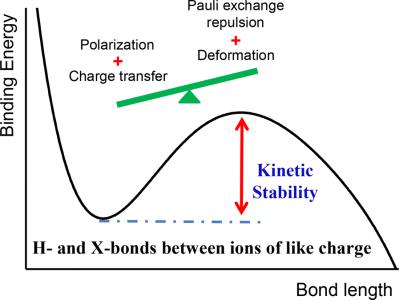当前位置:
X-MOL 学术
›
J. Comput. Chem.
›
论文详情
Our official English website, www.x-mol.net, welcomes your feedback! (Note: you will need to create a separate account there.)
Hydrogen- and Halogen-Bonds between Ions of like Charges: Are They Anti-Electrostatic in Nature?
Journal of Computational Chemistry ( IF 3 ) Pub Date : 2017-09-26 , DOI: 10.1002/jcc.25068 Changwei Wang 1 , Yuzhuang Fu 1 , Lina Zhang 1 , David Danovich 2 , Sason Shaik 2 , Yirong Mo 3
Journal of Computational Chemistry ( IF 3 ) Pub Date : 2017-09-26 , DOI: 10.1002/jcc.25068 Changwei Wang 1 , Yuzhuang Fu 1 , Lina Zhang 1 , David Danovich 2 , Sason Shaik 2 , Yirong Mo 3
Affiliation

|
Recent theoretical studies suggested that hydrogen bonds between ions of like charges are of a covalent nature due to the dominating nD→σ*H‐A charge‐transfer (CT) interaction. In this work, energy profiles of typical hydrogen (H) and halogen (X) bonding systems formed from ions of like charges are explored using the block‐localized wavefunction (BLW) method, which can derive optimal geometries and wave functions with the CT interaction “turned off.” The results demonstrate that the kinetic stability, albeit reduced, is maintained for most investigated systems even after the intermolecular CT interaction is quenched. Further energy decomposition analyses based on the BLW method reveal that, despite a net repulsive Coulomb repulsion, a stabilizing component exists due to the polarization effect that plays significant role in the kinetic stability of all systems. Moreover, the fingerprints of the augmented electrostatic interaction due to polarization are apparent in the variation patterns of the electron density. All in all, much like in standard H‐ and X‐bonds, the stability of such bonds between ions of like charges is governed by the competition between the stabilizing electrostatic and charge transfer interactions and the destabilizing deformation energy and Pauli exchange repulsion. While in most cases of “anti‐electrostatic” bonds the CT interaction is of a secondary importance, we also find cases where CT is decisive. As such, this work validates the existence of anti‐electrostatic H‐ and X‐bonds. © 2017 Wiley Periodicals, Inc.
中文翻译:

相同电荷离子之间的氢键和卤素键:它们在自然界中是抗静电的吗?
最近的理论研究表明,由于占主导地位的 nD→σ*H-A 电荷转移 (CT) 相互作用,相同电荷离子之间的氢键具有共价性质。在这项工作中,使用块局域波函数 (BLW) 方法探索了由相同电荷的离子形成的典型氢 (H) 和卤素 (X) 键合系统的能量分布,该方法可以通过 CT 相互作用推导出最佳几何形状和波函数“关掉。” 结果表明,即使在分子间 CT 相互作用被淬灭后,大多数研究系统的动力学稳定性虽然有所降低,但仍保持不变。基于 BLW 方法的进一步能量分解分析表明,尽管存在净排斥库仑排斥,由于在所有系统的动力学稳定性中起重要作用的极化效应,存在稳定组分。此外,由于极化而增强的静电相互作用的指纹在电子密度的变化模式中很明显。总而言之,就像标准的 H 键和 X 键一样,相同电荷离子之间的这种键的稳定性受稳定静电和电荷转移相互作用与不稳定变形能和泡利交换排斥之间的竞争控制。虽然在大多数“抗静电”键的情况下,CT 相互作用是次要的,但我们也发现 CT 起决定作用的情况。因此,这项工作验证了抗静电 H 键和 X 键的存在。© 2017 威利期刊公司。由于极化而增强的静电相互作用的指纹在电子密度的变化模式中很明显。总而言之,就像标准的 H 键和 X 键一样,相同电荷离子之间的这种键的稳定性受稳定静电和电荷转移相互作用与不稳定变形能和泡利交换排斥之间的竞争控制。虽然在大多数“抗静电”键的情况下,CT 相互作用是次要的,但我们也发现 CT 起决定作用的情况。因此,这项工作验证了抗静电 H 键和 X 键的存在。© 2017 威利期刊公司。由于极化而增强的静电相互作用的指纹在电子密度的变化模式中很明显。总而言之,就像标准的 H 键和 X 键一样,相同电荷离子之间的这种键的稳定性受稳定静电和电荷转移相互作用与不稳定变形能和泡利交换排斥之间的竞争控制。虽然在大多数“抗静电”键的情况下,CT 相互作用是次要的,但我们也发现 CT 起决定作用的情况。因此,这项工作验证了抗静电 H 键和 X 键的存在。© 2017 威利期刊公司。相同电荷离子之间的这种键的稳定性受稳定静电和电荷转移相互作用与不稳定变形能和泡利交换排斥之间的竞争控制。虽然在大多数“抗静电”键的情况下,CT 相互作用是次要的,但我们也发现 CT 起决定作用的情况。因此,这项工作验证了抗静电 H 键和 X 键的存在。© 2017 威利期刊公司。相同电荷离子之间的这种键的稳定性受稳定静电和电荷转移相互作用与不稳定变形能和泡利交换排斥之间的竞争控制。虽然在大多数“抗静电”键的情况下,CT 相互作用是次要的,但我们也发现 CT 起决定作用的情况。因此,这项工作验证了抗静电 H 键和 X 键的存在。© 2017 威利期刊公司。这项工作验证了抗静电 H 键和 X 键的存在。© 2017 威利期刊公司。这项工作验证了抗静电 H 键和 X 键的存在。© 2017 威利期刊公司。
更新日期:2017-09-26
中文翻译:

相同电荷离子之间的氢键和卤素键:它们在自然界中是抗静电的吗?
最近的理论研究表明,由于占主导地位的 nD→σ*H-A 电荷转移 (CT) 相互作用,相同电荷离子之间的氢键具有共价性质。在这项工作中,使用块局域波函数 (BLW) 方法探索了由相同电荷的离子形成的典型氢 (H) 和卤素 (X) 键合系统的能量分布,该方法可以通过 CT 相互作用推导出最佳几何形状和波函数“关掉。” 结果表明,即使在分子间 CT 相互作用被淬灭后,大多数研究系统的动力学稳定性虽然有所降低,但仍保持不变。基于 BLW 方法的进一步能量分解分析表明,尽管存在净排斥库仑排斥,由于在所有系统的动力学稳定性中起重要作用的极化效应,存在稳定组分。此外,由于极化而增强的静电相互作用的指纹在电子密度的变化模式中很明显。总而言之,就像标准的 H 键和 X 键一样,相同电荷离子之间的这种键的稳定性受稳定静电和电荷转移相互作用与不稳定变形能和泡利交换排斥之间的竞争控制。虽然在大多数“抗静电”键的情况下,CT 相互作用是次要的,但我们也发现 CT 起决定作用的情况。因此,这项工作验证了抗静电 H 键和 X 键的存在。© 2017 威利期刊公司。由于极化而增强的静电相互作用的指纹在电子密度的变化模式中很明显。总而言之,就像标准的 H 键和 X 键一样,相同电荷离子之间的这种键的稳定性受稳定静电和电荷转移相互作用与不稳定变形能和泡利交换排斥之间的竞争控制。虽然在大多数“抗静电”键的情况下,CT 相互作用是次要的,但我们也发现 CT 起决定作用的情况。因此,这项工作验证了抗静电 H 键和 X 键的存在。© 2017 威利期刊公司。由于极化而增强的静电相互作用的指纹在电子密度的变化模式中很明显。总而言之,就像标准的 H 键和 X 键一样,相同电荷离子之间的这种键的稳定性受稳定静电和电荷转移相互作用与不稳定变形能和泡利交换排斥之间的竞争控制。虽然在大多数“抗静电”键的情况下,CT 相互作用是次要的,但我们也发现 CT 起决定作用的情况。因此,这项工作验证了抗静电 H 键和 X 键的存在。© 2017 威利期刊公司。相同电荷离子之间的这种键的稳定性受稳定静电和电荷转移相互作用与不稳定变形能和泡利交换排斥之间的竞争控制。虽然在大多数“抗静电”键的情况下,CT 相互作用是次要的,但我们也发现 CT 起决定作用的情况。因此,这项工作验证了抗静电 H 键和 X 键的存在。© 2017 威利期刊公司。相同电荷离子之间的这种键的稳定性受稳定静电和电荷转移相互作用与不稳定变形能和泡利交换排斥之间的竞争控制。虽然在大多数“抗静电”键的情况下,CT 相互作用是次要的,但我们也发现 CT 起决定作用的情况。因此,这项工作验证了抗静电 H 键和 X 键的存在。© 2017 威利期刊公司。这项工作验证了抗静电 H 键和 X 键的存在。© 2017 威利期刊公司。这项工作验证了抗静电 H 键和 X 键的存在。© 2017 威利期刊公司。



























 京公网安备 11010802027423号
京公网安备 11010802027423号